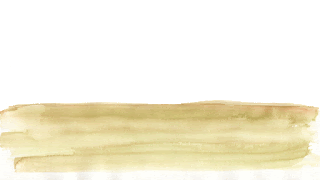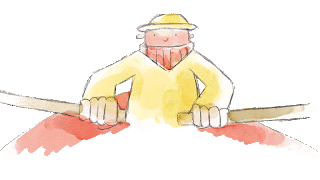OUAN505
Applied Animation 2
Brenda C
Muliawan
Student ID:
bm260478
EVALUATION
Animated
Documentary is something that I have been looking forward to since the start of
the year, and I was full of expectation that I will be doing something rather
abstract and involves treatment of sound. However, it did not go as I want it
to be, as I ended up doing another character animation again. Despite not going
according to plan, the decision is for the best interest of the group and I
enjoyed doing the module because I got to get my hands on watercolour animation
for the background in our animation, instead of doing the character animation.
For this
project, I am in a group of three with Rosie Summers and Tom Hallgarten, who
shares the interest towards the theme sustainability. At first, we wanted to do
a documentary animation about fracking with an angry tone of voice, however the
project shifts after we met globe-trotting storyteller Devi Lockwood who shared
a lot of interesting stories about climate change from audio recordings told by
people she met during her travel. Meeting
her is only possible because Rosie came up to Devi during a Frack-Free Leeds
meeting when Devi gave a presentation about her journey collecting stories and while
getting involved in environmental activism through joining campaigns and conferences
in different places. We arranged a quick meet up with her the day after her
presentation because she is leaving for London, in which we had a chat with
Devi about how the idea of collecting stories about climate change and water
comes about, the painstaking process to get her ideas funded and about the
people that she met when travelling. We are lucky to be able to get in touch
with Devi before she left because we found the right person that has a lot of
stories to share and is passionate about the storytelling itself. While waiting
for Devi’s audio recording, we still carried our research on fracking and went
to Knostrop waste treatment centre to observe the environmental implication of
the fracking waste in its surrounding. Although we proceeded with Devi’s story
in the end, the walk to Knostrop is not for nothing. It helps us to understand
the pressing need to make the public aware about the environmental issue and
the bigger of sustainability.
We selected Noelline's story over the others because the personal narrative stood out from many potential topics that we can explore in our animation. We chose to take a straightforward approach in narrative storytelling using characters that the audience can relate to, and this is where the choice of media plays its part. We had decided to incorporate traditional watercolour aesthetic into our animation because of its organic outcome, yet this raises another ethical issue as the process
of hand-painting the animation would use up a lot of paper and it contradicts the idea of being sustainable. After consulting some of the tutors, they suggested us to try out the Kyle Watercolour Brushes on Photoshop. We raised this concern during the first crit, and my classmates are supportive towards the hybrid style we want to use. Although it seems contradictory to the hand-crafted look I am after, I have to compromise in the end because the hybrid method is definitely more feasible than just doing everything traditionally. I helped Rosie to do tests on the backgrounds, and try to blend in the Kyle Brush texture into the traditional watercolour background aesthetic, in which I discovered the method of colouring on top of block white layer. Although there is a disparity between these two styles, the painting technique that Rosie and I discovered works well as a whole.
The moment that I enjoyed the most in this project is when I am painting the animated backgrounds because the process is therapeutic. Tom had raised a good point - after looking at my experimentation in the thumbnails I made in my sketchbook - by telling me to keep the background painting and the water animation slightly abstract. My method of using big brushes allows me to create characteristic brush strokes. What I did most of the time is trying to imagine the different energy of the water. The strokes produced depends on my mood at a certain point of time, and therefore, if I start doing a water animation I cannot stop until it is done. I feel satisfied with the degree of clarity of self-expression that I have achieved when painting this water.
I faced challenges in this project in which I have to compromise a lot in when it comes to conceptual ideas because I am working with a bigger group as compared to what I used to in the previous Character and Narrative module. Things did not go as well as I expected it to be, and I cannot really say that I am passionate of the work that I did on this project because I maintained a passive stance from the start. I did not feel that I learnt anything significant by the end of the project new aside for painting the watercolour animation. Despite not being passionate in the working aspect, I am definitely proud by the outcome. The final animation really reflects the power of our team and our passion towards the sustainability issue. We have realised the idea by working based on our strengths and has successfully made an animation that brings out the realism out of Noelline's recount, which can serve as an art that leads people into discussion and hopefully can affect social, economical, ethical and environmental aspect in the world. Our submission to the Leeds College of Art Sustainability Award has reflected our believe in this animation that it has the potential to inspire artists to come up with projects that revolves around sustainability and environmental issue. Overall, this 16 weeks of collaboration with Tom and Rosie have been a great one. We managed to persevere through the tasking process of making a 2-minute documentary animation and stay together as a team until the end. Ultimately, we have successfully create an animation that gets across Noelline's recount on the destructive nature of flood through emotive storytelling. Looking at what Devi does and by doing this project has motivated me to carry on tackling the issue of sustainability and climate change, and I hope that this will continue to inspire me to try my best to be good for the mother nature in any sort of way.























































